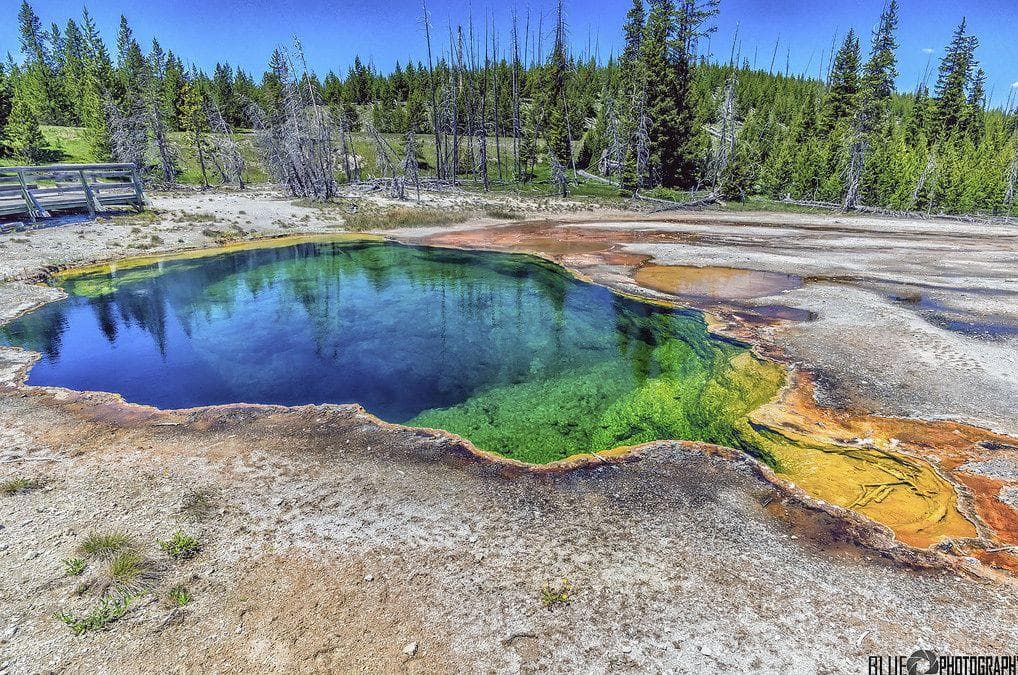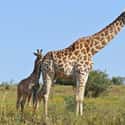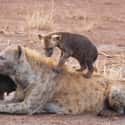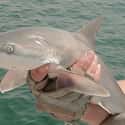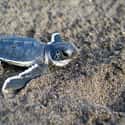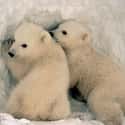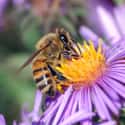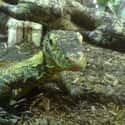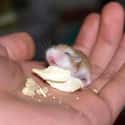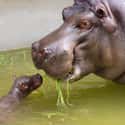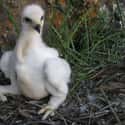-
(#1) Giraffes Have To Survive A Six-Foot Drop And Learn How To Walk In An Hour
Baby giraffes may seem fragile because of their thin bones and long necks, but the truth is that they're actually beasts of survival. A baby giraffe has to go to great lengths to survive - literally. Female giraffes give birth standing up, which means that their little ones have to fall over six feet down to the ground - they're basically thrown out of a first-floor window! Worse yet, they have to come out of the womb running - giraffes have lots of natural predators, so newborns have to learn how to stand, walk, and run all within an hour, or face imminent doom.
-
(#2) Spotted Hyenas Must Learn To Kill Or Be Killed
Spotted hyenas have to come out of the womb swinging. They're born with open eyes and sharp teeth, and their entire childhood revolves around battling their siblings to establish dominance. The weaker cubs almost always meet a certain death, even though hyena's only natural predators are in fact each other.
The fighting can become so brutal between cubs that adult hyenas sometimes try to separate their pups, who just begin fighting again as soon as they're left alone. These battles often go on for weeks, or until weaker cubs are fatally injured. And the weaker cubs who don't happen to die from their injuries are usually so abused that they are too terrified to leave their burrows when their mothers come home to feed them. So even these cubs eventually die of starvation in their borrows, alone.
-
(#3) Shark Babies Eat Their Siblings
Surviving as a sand shark is pretty rough - and chances are you won't even end up being born because your older brother or sister will have eaten you while you were still in your egg. Sand shark eggs hatch in the womb in different layers, so those who hatch first get a head start and end up eating the eggs that fell behind. And once all of the eggs are gone, they move on to actually cannibalizing their smaller, weaker siblings. Talk about a sibling rivalry.
-
(#4) Baby Sea Turtles Make A Long, Treacherous Journey To The Sea
When baby sea turtles hatch, they're completely on their own and without protection from mom or dad. Once they break out of their eggs, they have to crawl out from under the sand and make a long, treacherous journey into the sea with only their instincts to guide them. These animals have no protection against the birds that often scoop them up for a quick meal. And if they're lucky enough to not get eaten by a bird, they still have to watch out for the crabs that'll try to pull them back underground to eat them alive. Sadly, only 1% of sea turtle hatchlings actually manage to survive into adulthood.
-
(#5) Polar Bear Cubs Face Starvation, Freezing Temperatures, And Predators
Polar bear moms make every effort to protect their young, but often it's not enough. Cubs are lucky enough to be born in a comfy snow den that protects them from temperatures that get as low as -20 degrees Fahrenheit, and these tiny creatures feed off mom's milk until they're ready to hunt on their own. But when a cub is between three and four months old, it will venture out into the dangerous wilderness - a wasteland of water, ice, and snow. This is when life gets hard. With melting ice caps and rapidly shrinking populations of seals, mother polar bears often struggle between starving or eating their young, as they only have so much fat stored away and cannot produce milk if they're malnourished. If a polar bear isn't eaten by its mom in a last-ditch effort to survive, it's likely that the cub will die of starvation anyway.
-
(#6) Out Of All The Honey Bee Larvae, Only One Queen Can Survive
The odds are pretty bad when only one of your siblings can survive. This is the case for honey bee larvae vying to be royalty. Most honey bee larvae have nothing to worry about, but when a queen bee starts growing old, a new one needs to be crowned.
Worker bees (sterile females who produce honey and find food for their colony) select a few larvae and move them into a special area of the hive. These larvae are fed mass amounts of royal jelly, an ultra-nutritious food that helps them grow into fertile queens. Then, at a certain age, these future queens build cocoons and undergo metamorphosis in order to become adult bees. However, since there can only be one queen, whichever bee emerges from their cocoon first will sting the others to death before their metamorphosis is through. If more than one Queen emerges at the same time, they battle to the death. Only one can survive, and as soon as there is a victor, the worker bees kill the old queen and the new one immediately takes the throne.
-
(#7) Komodo Dragons Roll Around In Poop To Deter Cannibalistic Adults
Though some female Komodo dragons have the ability to lay eggs without a male's sperm, if these fatherless-eggs end happen to hatch, then they're in for a pretty tough life. Baby Komodo dragons tend to hangout in trees in order to avoid predators, but their biggest predators are actually their own kind. Young Komodo dragons actually make up 10% of an adult's diet because medium-sized prey is pretty rare on the islands and something has to sustain their extra-large appetite.
However, young Komodos have come up with some pretty gross tactics to ward off adults. They often eat by scavenging from the dead animals killed by other Komodos. And when they approach a kill, they will roll around in their own feces and the dead animal's intestines in hopes of deterring hungry, cannibalistic adults.
-
(#8) Adorable Baby Hamsters Have To Survive Their Cannibalistic Mothers
You thought your mom was mean, but momma hamsters are in a whole different category. Female hamsters will frequently kill their own young, and they have no shortage of excuses. Stressed new mommas will just knock out a few from their brood to make things easier on themselves. If the mom feels she can't care for a litter of a certain size, she'll kill some of her babies to save the others - especially if food is scarce. Once hamster moms are done, they'll often cannibalize their young. A baby hamster must always make sure they stay on mom's good side.
-
(#9) Baby Crocodiles Must Be Dug Out Of The Ground Before They Suffocate
Baby crocodiles are born buried alive - and they must escape from their shells and yell for their mother to come dig them out of the ground. If their mother doesn't dig them out in time, they suffocate and die.
Once a mother crocodile digs out her young, she'll carry them in her mouth to the water where they have to instantly learn how to swim, hunt, and avoid all of the things that are trying to kill them. Mothers keep a watchful eye on their babies, who emit a special scent to let mom know they're hers. However, after a few short weeks, mother crocs bail and their children have to fend for themselves. On top of being left completely alone at such a young age, crocodiles are very violent and often attack each other. Over half of all baby crocodiles don't even live beyond a year.
-
(#10) Baby Hippopotamuses Nearly Drown As Soon As They're Born
Baby hippos are born underwater without the ability to swim or breath. As a result, the immediate risk of suffocation is immense, and they have to rely on their mothers to dive down and pull them up to the surface where they can finally take their first breath.
A baby hippo must instantly learn how to swim and hold its breath underwater or it will either die of drowning or starvation, as baby hippos need to swim underwater to get milk from their mothers. Baby hippos also have a number of natural predators including lions, leopards, and crocs, but their biggest killer is dehydration - baby hippos don't have sweat glands so they can't stay out of the water for very long.
-
(#11) Golden Eagle Chicks Are Essentially In The Hunger Games
Golden eagles rarely lay eggs, but when they do they have just one or two eggs per nest. And when these eggs hatch, the chicks enter into a Hunger Games-type competition for survival.
Most often, one egg will hatch before the other. This chick then ends up being fed before the other is born and grows much more quickly. When the second is finally born, is can never quite catch up to its older sibling. Because a firstborn chick is so much bigger and stronger, it usually wins fights for food, causing most second born chick to die from malnutrition. And if the younger chick doesn't happen to die right away, as soon as food becomes scarce it will be eaten by its older sibling. It's estimated that 80% of second-born golden eagles die this way.
New Random Displays Display All By Ranking
About This Tool
We are lucky to watch the life and growth of real wild animals in various nature documentaries. Most people are always attracted by cute and naive baby animals, but the truth of nature is more brutal than our imagination, baby animals have to accept the ultimate challenge of nature in the most fragile stage of life, that is, the first few weeks or months of their life.
Baby animals usually depend on their parents for their lives, the few weeks or months after birth are the most critical period in their lives. They need to learn to hunt and defend their enemies independently in a cruel nature. The random tool introduced 11 baby animals that have to go through brutal challenges to survive.
Our data comes from Ranker, If you want to participate in the ranking of items displayed on this page, please click here.





